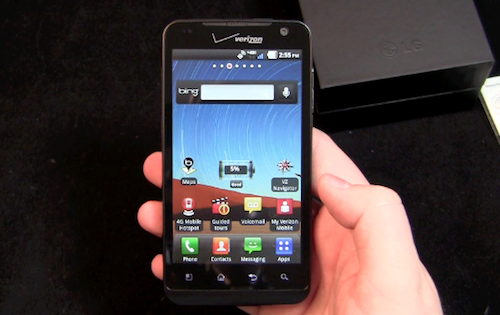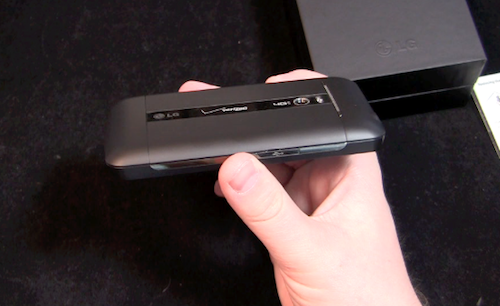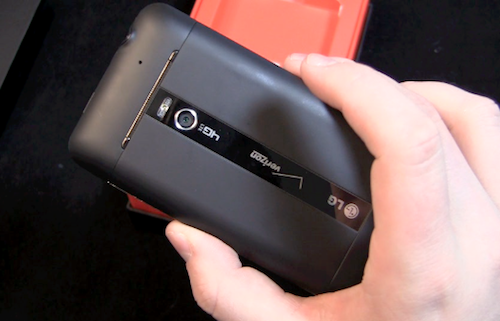
I've spent the weekend toying with the LG Revolution, and sadly, I've been very disappointed. After hitting it out of the park with the T-Mobile G2x, I expected quite a bit from LG's newest superphone. It's not as bad as the company's most troublesome smartphone - the LG Ally - but it's a step down from the G2x, and more importantly, the other 4G LTE devices in Verizon's lineup. It retails for $249.99 with a two-year agreement, which led me to wonder why anyone would consider this device over the HTC ThunderBolt.
Here's what I've discovered in my time with it:
- Revolution is bulky, but looks good. The silver strip around the camera accentuates the back, and the chrome sides go nicely with the black housing.
- LG and Verizon have packaged the Revolution with a 16 GB microSD card. Combined with the 16 GB of internal storage, it makes for a good media device. On that note, it's the first Android device to come with Netflix pre-installed. With the HDMI port, you can connect it to your television and stream Netflix movies. Quite the nifty feature and nice that it works out of the box, though there are other Android devices that can do the same thing.
- The 4.3-inch screen isn't bad by any means, but it's nothing exceptional. Colors seem slightly washed out, and the difference in quality is noticeable when held up against the ThunderBolt and DROID Charge. The screen is also unresponsive at times; on several occasions, I had to tap numbers, applications, or the "end" key twice before the phone would respond.

- Revolution ships with Android 2.2 and a custom LG user interface. When you get into the various Android user interfaces, there's a certain level of subjectivity from any reviewer, so I highly suggest testing the Revolution's user interface in-store to determine if you like it. That said, I don't care for the way it's implemented; it feels like it was hastily put together, and exudes a cheap, toy-like feel. Inside, you'll find a custom LG keyboard and Swype, and while the LG QWERTY pales in comparison to industry favorites like HTC's Sense and Motorola's multi-touch keyboards, it gets the job done.
- It's the first LTE device (and one of the few high-end Android phones) to ship with Bing instead of Google. I don't mind Bing - in fact, I find that it works quite well - but Android/Google fans will be frustrated with it. Since it's not a "with Google" device, you'll need to download Google Maps from the Android Market.
- Powered by a 1 GHz Snapdragon processor, Quadrant Standard scores would lead you to believe that the Revolution is the fastest device in Verizon's 4G crop. My unit consistently scored at around 1,800, though day-to-day use tells a different story. It suffers from lag when performing basic tasks like scrolling through homescreens, and is unpredictable. One moment, the lag will be there; the next moment, the lag will be gone. While the lag is a problem, the real irritation is the inconsistency of it.

- Signal strength has been decent so far. Callers have reported favorable results, and I've been able to hear them well. The earpiece volume is nice and loud, and it had no problem connecting to my Bluetooth headset. Data speeds have been on par with Verizon's estimated 4G download and upload speeds. In testing, my download speeds were between 10 and 12 Mbps, while upload speeds were between 3 and 7 Mbps.
- 4G connectivity and a 1,500 mAh battery never translates into a good battery life experience, but I was shocked at how quickly the Revolution drained. I pulled it off of the charger on Saturday morning at 9:00 AM, and with light use including a few text messages, browsing the web twice, and downloading three apps, the phone was at 52 percent at 12:00 PM. Adding to the battery woes, it takes an unusual amount of time to charge, so those that live by 10 minute charges between meetings will want to look elsewhere.
So far, the Revolution…well…hasn't been very revolutionary (had to do it, sorry). LG missed a prime opportunity to knock it out of the park with an awesome superphone on the nation's largest wireless carrier. Revolution is watered down with a somewhat confusing UI, and doesn't offer any distinguishing features to push consumers to it as opposed to the ThunderBolt or DROID Charge.
Check out the unboxing, and stay tuned for more coverage!


